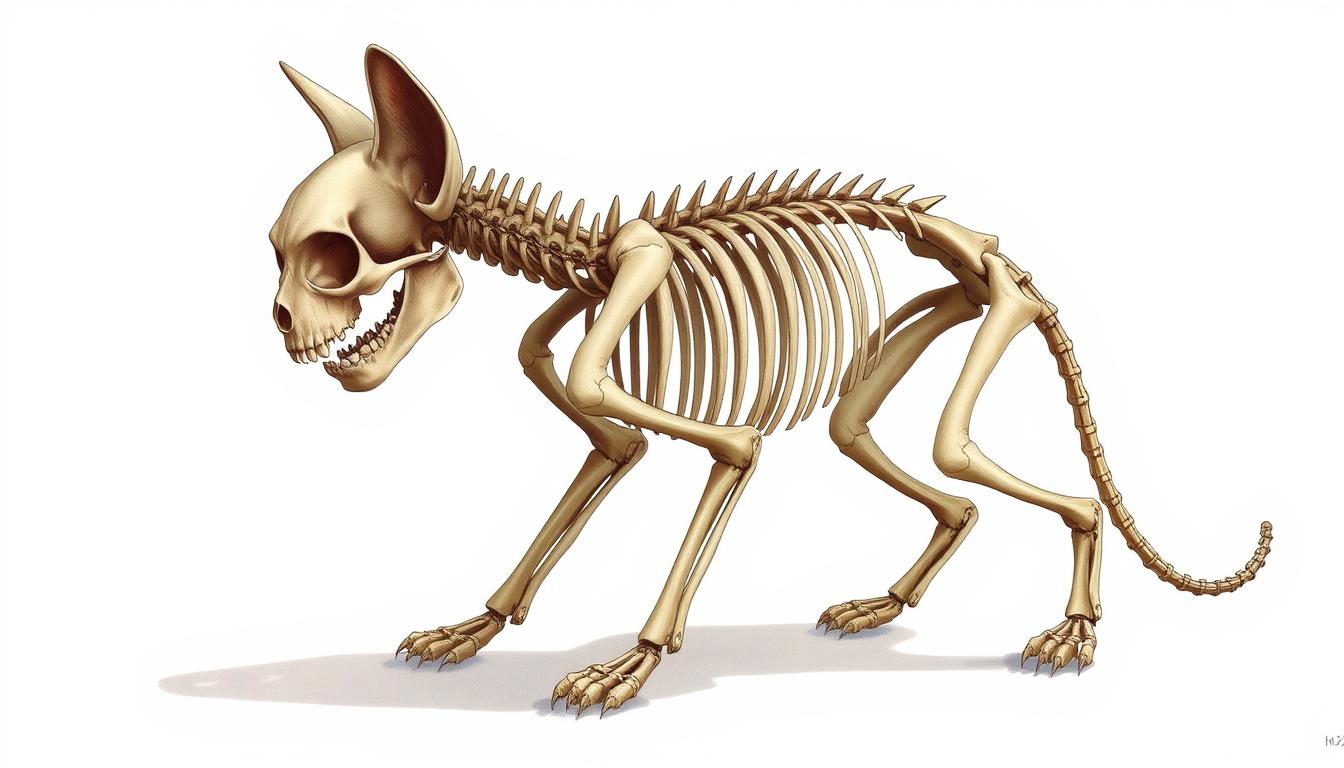As a devoted cat owner, I’ve always been amazed by their agility and flexibility. They can leap, twist, and land on their feet with grace. But have you ever wondered about the skeletal system that makes this possible? Let’s explore the cat skeleton and discover what makes these pets so special.
Table of Contents
Introduction to Feline Skeletal Anatomy
Cats have a flexible skeleton with about 230 bones, more than humans’ 206. Their bones support their hunting lifestyle, making them unique. Knowing about their skeleton helps us understand their agility and special abilities.
Basic Structure Overview
The cat’s skeleton is split into three parts: the axial, appendicular, and splanchnic skeletons. The axial includes the skull, spine, and ribs. The appendicular is the limbs and girdles. The splanchnic supports the soft organs. This setup helps cats move fast and stay agile.
Evolution of Cat Bones
Millions of years of evolution have shaped the cat’s bones for hunting. They have 7 cervical, 13 thoracic, 7 lumbar, and 3 sacral vertebrae, plus 22-23 caudal vertebrae. Without a collarbone, their front limbs move more freely, perfect for hunting and climbing.
Comparison with Human Skeleton
Cats and humans share some bone features, but they’re different. Cats lack a collarbone, giving them more flexibility. Humans have a skeletons better for walking upright. These differences show how each species evolved to fit their needs.
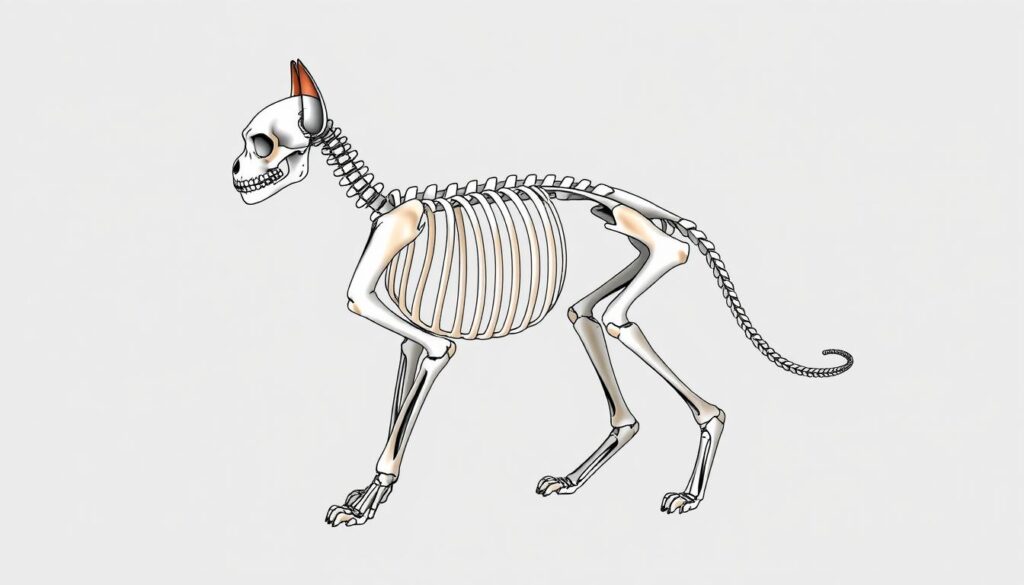
“The cat is a master of the art of living, and no one can learn so much about the art of living as a cat.”
– Fernand Méry
Cat Skeleton: Components and Count
As feline lovers, we find the Skeletal Structure of cats fascinating. Their Osteology shows how they evolved to be agile and graceful. This anatomy is a key to their unique abilities.
Did you know cats have 230 bones? Their skeleton includes the skull, spine, ribs, limbs, and tail. The spine alone is impressive, with 7 cervical, 13 thoracic, 7 lumbar, 3 sacral, and 22-23 caudal vertebrae in the tail.
Cats have 13 pairs of ribs and powerful limb bones. These bones help them jump and run fast. Their skull has 30 teeth, including sharp molars for tearing meat.
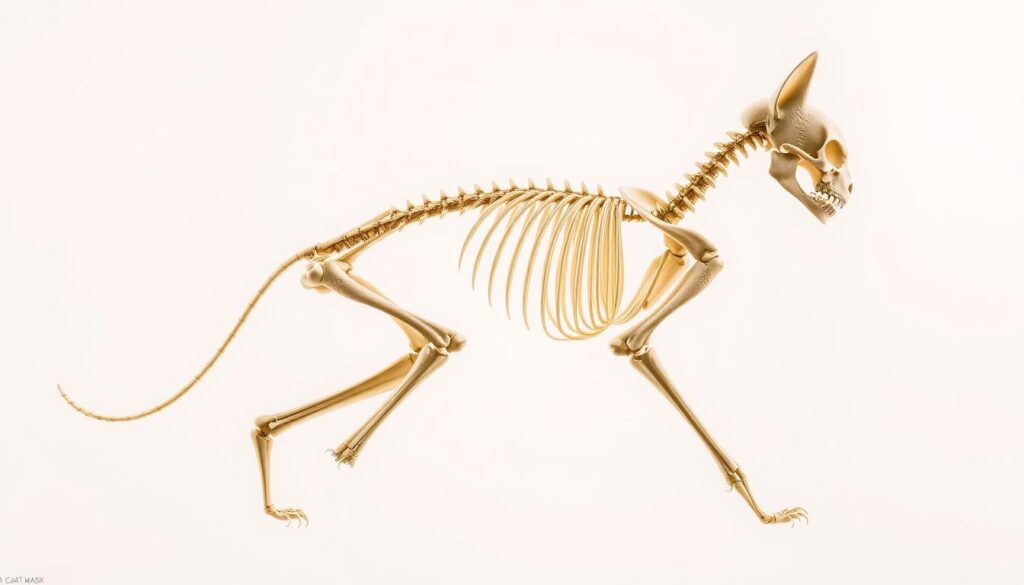
The Skeletal Structure of cats is a result of millions of years of evolution. From tail to skull, their Osteology is amazing. It lets them move and hunt well in many places.
- Cats have 230 bones, including ribs, tails, vertebrae, and limbs.
- Kittens have 26 primary teeth, and adult cats have 30 permanent teeth.
- Cat skeletons are similar to humans but have more bones. They have special features for hearing, flexibility, and hunting.
Learning about cat Skeletal Structure and Osteology helps us understand them better. It shows how their anatomy makes them successful and interesting pets.
The Unique Vertebral Column
The cat’s spine is a true marvel of nature. It’s made up of bones called vertebrae that work together. This setup gives cats amazing flexibility and agility.
Learning about the cat’s spine can teach us a lot about their biology and how they’ve adapted to their lives.
Cervical Vertebrae
Cats have 7 cervical vertebrae at the top of their spine. These bones let their heads and necks move in many ways. This helps them see around, chase prey, and even talk to each other through body language.
Thoracic and Lumbar Regions
Below the cervical vertebrae, cats have 13 thoracic vertebrae and 7 lumbar vertebrae. These parts are key for their fast movements and powerful jumps. The muscles in the lumbar area are especially strong, helping cats move with ease.
Caudal Vertebrae and Tail Function
The cat’s tail, with 18 to 23 caudal vertebrae, is incredible. It helps cats balance when they move quickly. The tail also lets cats show their feelings through tiny movements.
Special discs between the vertebrae help absorb shocks. This lets cats move freely and land safely on their feet.
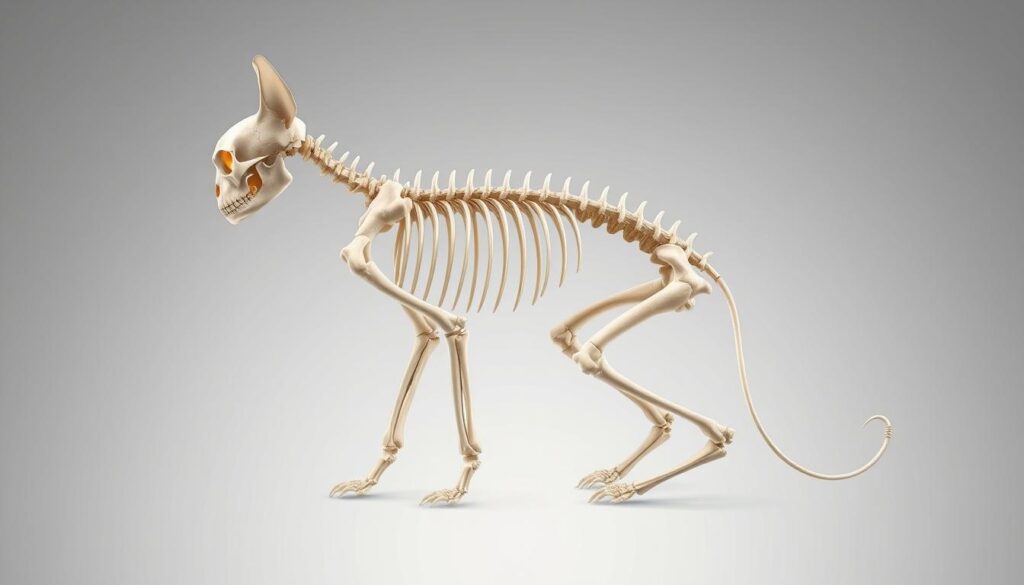
Skull and Dental Structure
The cat skull is special for their hunting life. It has big eye sockets and 30 teeth. This makes them great at catching and eating prey.
The dental formula of a cat includes:
- Incisors for biting
- Canines for tearing
- Premolars for shredding
- Molars for grinding
Cats can easily grab, tear, and eat their prey. Their jaws are strong and can open wide. This helps them hold onto big prey.
The cat skull also has strong jaw muscles and bones. These help them hear well, which is key for finding and tracking prey. The space between their canines and premolars helps them grasp and tear food.
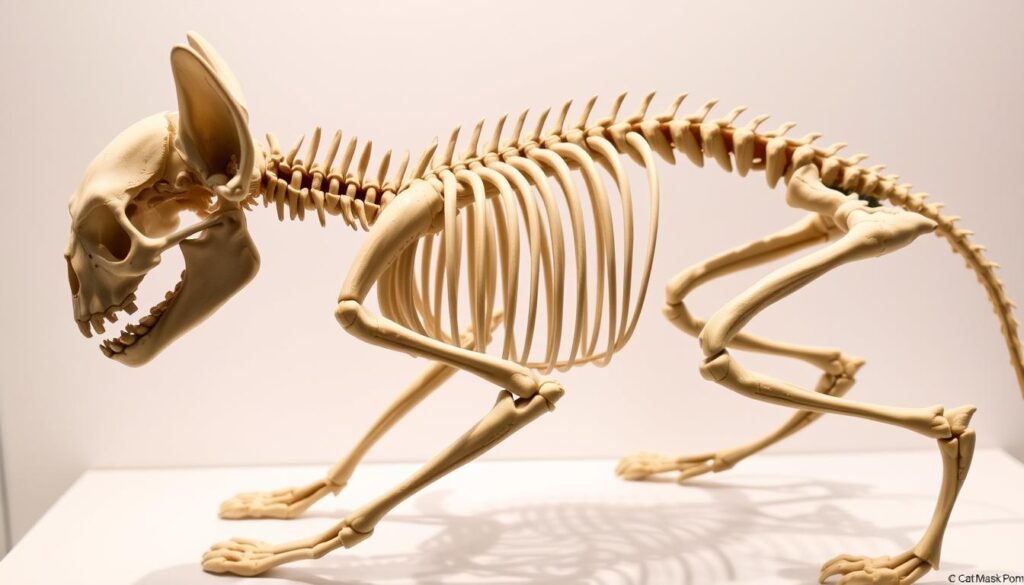
“The cat skull is a true marvel of Veterinary Science. It shows how felines have evolved to be such skilled Cat Skeleton hunters.”
Limb Architecture and Mobility
The feline skeletal structure is made for agility, power, and precision. The Skeletal Structure of a cat’s limbs is key to their amazing mobility and hunting skills. We’ll look at the special features of their front and hind legs, and how their paws and claws work together.
Front Leg Anatomy
Cats have a special Feline Anatomy clavicle or collarbone. This lets their front legs move more freely. It helps them climb, pounce, and swat with ease.
Hind Leg Structure
The hind legs of cats are very strong. They have muscles for jumping and running. This lets cats leap and run fast, making them great hunters and survivors.
Paw and Claw Mechanism
Cats walk on their toes, a digitigrade stance. Their front paws have four toes and one dewclaw. The hind paws have four toes too. Their retractable claws are controlled by tendons and muscles for precise movements.
Cats’ unique limb architecture and mobility come from millions of years of evolution. It helps them thrive in different environments and excel as skilled hunters and agile predators.
“The cat is a master of its own movements, a connoisseur of comfort, and a shrewd observer of the human condition.”
The Role of the Collarbone
Cats have a unique skeletal structure that sets them apart from other mammals. One key difference is their reduced collarbone or clavicle. Unlike humans, cats have a small, free-floating clavicle that doesn’t connect to any other bones.
This unique feature in the cat skeleton is crucial. The lack of a fully developed collarbone lets cats squeeze through narrow spaces. It also gives them more flexibility in their front limbs. This flexibility is vital for cats to move easily and escape dangers.
Moreover, the reduced collarbone helps cats rotate their body in mid-air during falls. This skill allows them to land on their feet, often without getting hurt. The flexibility and agility of cats’ skeletons make them stand out from other animals.
| Cats | Humans |
|---|---|
| Cats have a reduced collarbone (clavicle) that is not connected to other bones. | Humans have a prominent collarbone (clavicle) that connects the shoulder blade to the breastbone. |
| The reduced collarbone allows cats to squeeze through narrow spaces and provides greater flexibility in their front limbs. | The human collarbone provides stability and support for the shoulder joint, but restricts flexibility in the upper body. |
| The reduced collarbone helps cats rotate their body in mid-air during falls, enabling them to land on their feet. | The human collarbone provides stability and support for the shoulder joint but restricts flexibility in the upper body. |
The unique skeletal structure of cats, especially their reduced collarbone, shows their evolutionary adaptations. By studying the Cat Skeleton and Comparative Anatomy, we learn about their amazing abilities. These insights highlight the agility and resilience of these animals.
Rib Cage and Thoracic Structure
The feline skeletal anatomy is a remarkable feat of engineering. The rib cage is a prime example of this intricate design. It has 12 pairs of ribs that protect the heart, lungs, and other essential organs.
This bony cage not only safeguards these vital organs. It also helps cats breathe efficiently. This allows them to stay agile and athletic.
Protection of Vital Organs
The ribs, sternum, and thoracic vertebrae form a sturdy enclosure. This protects the cat’s delicate internal organs from harm. The true ribs (1-7) are directly connected to the sternum.
The false ribs (8-10) and floating ribs (11-12) add extra protection. This intricate Feline Anatomy keeps the heart, lungs, and other critical structures safe. Even during strenuous physical activities.
Breathing Mechanics
The thoracic structure is key to the cat’s breathing. The intercostal muscles, between the ribs, contract and relax. This helps the rib cage expand and contract during breathing.
This process allows cats to take in oxygen and expel carbon dioxide. It’s essential for their Veterinary Science-approved respiratory system.
| Thoracic Wall Components | Characteristics |
|---|---|
| 12 pairs of ribs | Classified into true, false, and floating ribs |
| Sternum | Composed of manubrium, body, and xiphoid process |
| Thoracic vertebrae | 12 vertebrae that articulate with the ribs |
| Muscles, fascia, and skin | Connect the bony structures and facilitate movement |
The feline thoracic structure is a remarkable example of Feline Anatomy. It shows how cats can thrive in their environment. By understanding the rib cage’s protective function and breathing mechanics, we can appreciate their remarkable adaptations.
Joint Systems and Flexibility
Have you ever noticed how agile your cat is? It’s because of their special joint systems. These systems have evolved over time, making cats incredibly flexible and agile.
Cats have ball-and-socket joints in their shoulders and hips. This lets them move freely and jump high. Their spine also has many joints, allowing them to twist and turn easily.
The elbow and knee joints help cats move fast and powerfully. This is great for hunting and running. Their tail joints also help with balance and communication. All these joints, along with fast-twitch muscles, make cats very agile and graceful.

